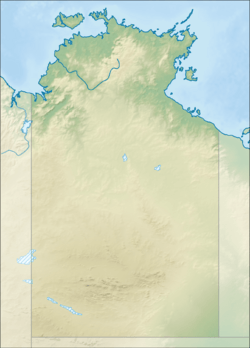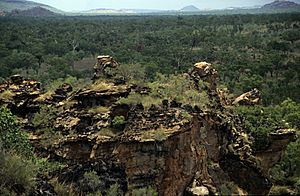Keep River facts for kids
Quick facts for kids Keep |
|
|---|---|
|
Location of the Keep River mouth in the Northern Territory
|
|
| Country | Australia |
| Territory | Northern Territory Western Australia |
| Region | Victoria Bonaparte (IBRA) |
| Physical characteristics | |
| Main source | 132 m (433 ft) |
| River mouth | 0 m (0 ft) 15°08′45″S 129°12′9″E / 15.14583°S 129.20250°E |
| Length | 258 km (160 mi) |
| Basin features | |
| Tributaries |
|
The Keep River is a river in Australia. It flows through the Victoria Bonaparte area. This region is found in both Western Australia and the Northern Territory.
Where is the Keep River Located?
The Keep River starts south of the Newry Station homestead. It flows north and crosses the Victoria Highway. Then, it goes through the Keep River National Park.
The river then turns west into Western Australia. After a short distance, it turns east again. It flows back into the Northern Territory. Finally, it continues north. The river empties into the Joseph Bonaparte Gulf and the Timor Sea.
How Big is the Keep River Area?
The area where the river collects its water is called a catchment. The Keep River's catchment covers about 6,003 square kilometers. This area is located between the Ord River to the west and the Victoria River to the east.
The river carries a lot of water. On average, it releases about 500 gigalitres of water each year.
Wetlands and the River Mouth
The lower parts of the river have important wetlands. These areas are perfect homes for many birds. Waterfowl use them for breeding. Migratory shorebirds also use them as resting spots.
You can also find large areas of rice-grass floodplains along the river. These are grassy areas that get flooded.
The estuary is where the river meets the sea. The Keep River estuary is very clean and natural. It covers about 230 square kilometers of open water. The tides strongly affect this area. It has many channels and is surrounded by about 55.5 square kilometers of mangrove trees.
What Plants Grow Along the Keep River?
Along the edges of the river, you can find many types of plants. These are called riparian plants. Some common plants include Melaleuca trees and Barringtonia acutangula. You might also see Nauclea orientalis, reeds, and taro. These plants are common in the upper parts of the river.
In the pools along the river, you can find sponges like Spongillidae growing on rocks. As you get closer to the national park, more water plants appear. These include species of Nymphea, Hydrilla verticillata, and Chara. They can form thick mats in some areas. Other plants along the river include Lysiphyllum cunninghamii and Pandanus spiralis.
What Animals Live in the Keep River?
Many different fish live in the Keep River. Some interesting ones include:
- Freshwater Sawfish
- Dwarf Sawfish
- Ox-eye Herring
- Bony Bream
- Short-tail Thryssa
- Several types of catfish, like Arius and Anodontiglanis dahli
- Freshwater Longtom
- Species of Rainbowfish
- Hardeyheads
- Species of Glassfish
- Species of Grunter
- Species of Mullet
- Spotted Archerfish
- Species of Gudgeon
- Species of Goby
- And the famous Barramundi!
History of the Keep River
The traditional owners of the land around the Keep River are the Kadjerong and Duulngari peoples in the north. The Miriwung peoples live to the south.
The river's name is believed to come from Henry Francis Keep. He was a storekeeper in a town called Wyndham. The first time the name "Keep River" was written down was in 1894. This was in the diary of an explorer named Michael Durack. He wrote about a "trip to Keep River."



